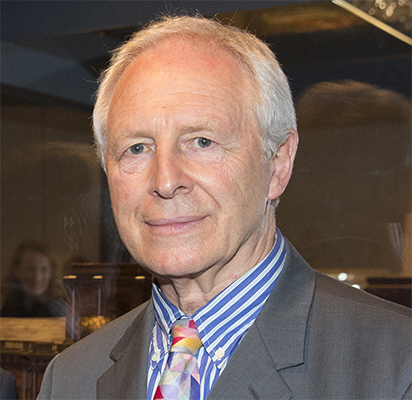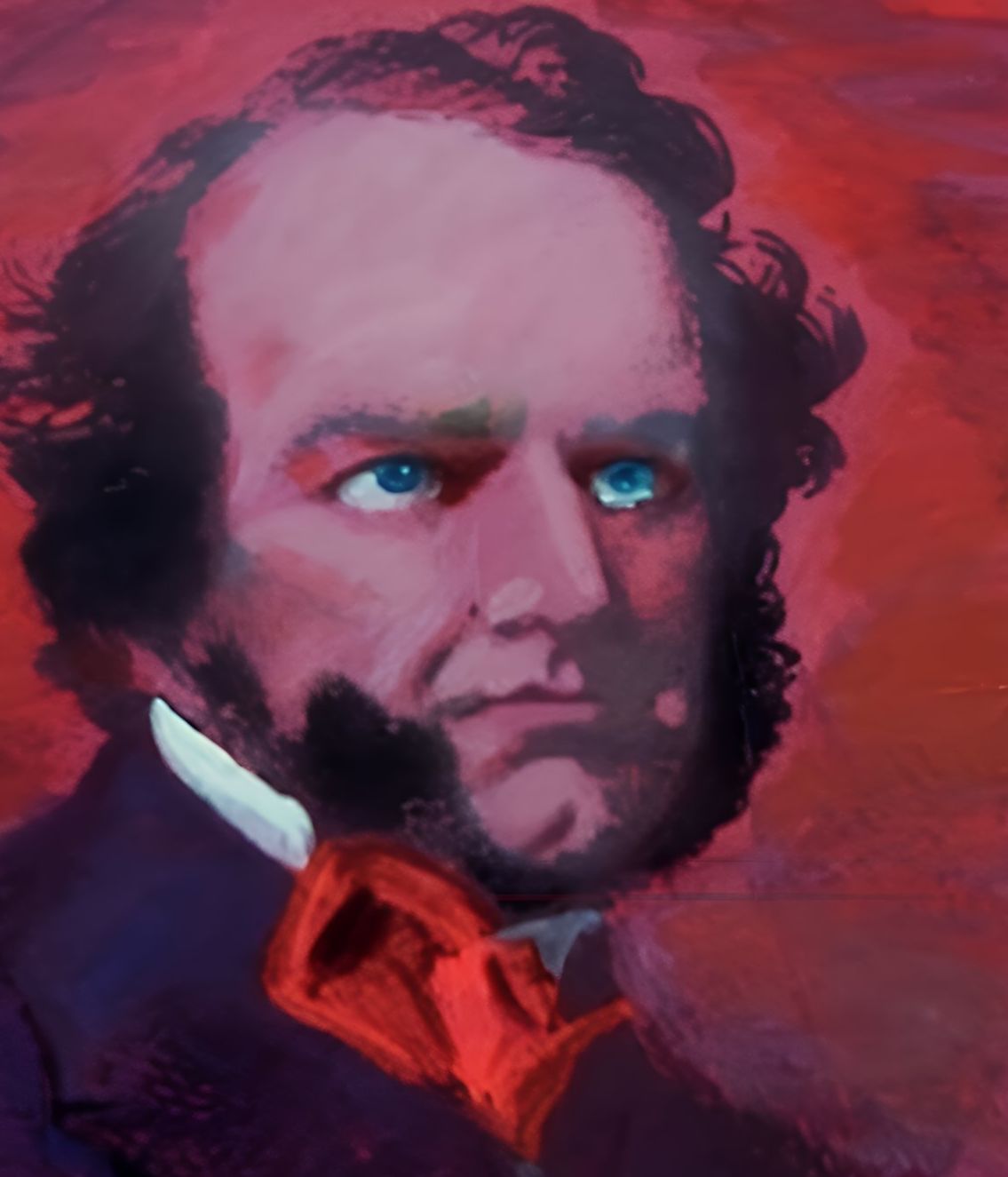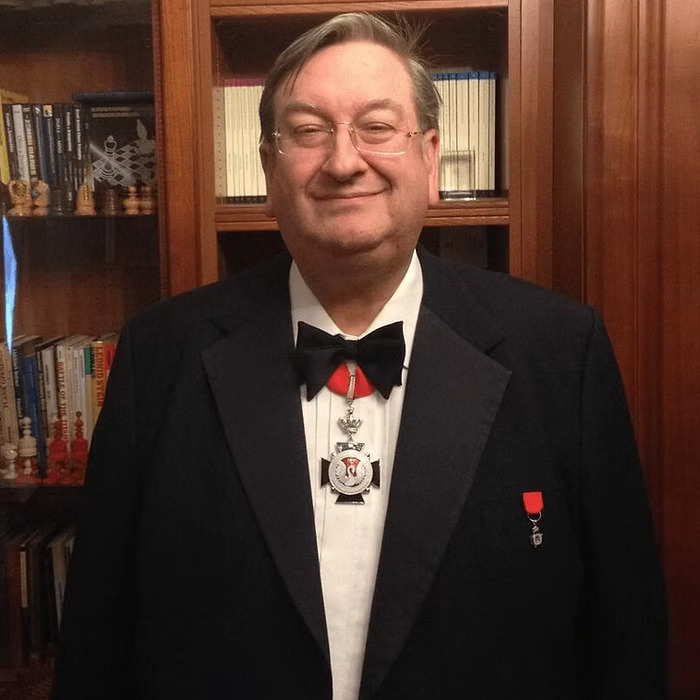Howard Staunton's Portrait
The Story Behind The Painting
by barry martin
I painted Howard’s portrait in the late 1990s, following the formation of The Staunton Society and establishing one of its main aims to mark his unmarked grave site in Kensal Green Cemetery, north London. This was achieved with a memorial fitting Howard’s immense national and international standing! The absence of any grave memorial was a national disgrace, and a letter written by me and signed by several Grandmasters was published as a leading letter in The Times to that effect!
I mention these facts, as my research into Howard’s profile unearthed features about the man that influenced my understanding and potential imaging of him. The fact that he was a polymath, recognised as the World Chess Champion in the 1840’s after winning against St. Amant in Paris in 1843; a recognised and eminent Shakespearean actor, who would be stage savvy and possess a remarkable memory to carry off such public performances; an educator, who organised the first truly international chess tournament in the 1850’s and so on. All of these faces, facets of Staunton, coloured my palette while preparing his portrait.


He died poor, which is why he was buried on the paupers' side of Kensal Green Cemetery, next to the Regent’s Canal, where the water table is high, affecting the burials adjacent to it in an adverse manner.
All of this added to my research and attempts to uncover past images of the great man. He couldn't pop round to my studio to sit for me, being otherwise engaged! I found around ten drawn illustrations of him and one daguerreotype from his late dotage, with others where he is unrecognisable, his face and head being almost entirely covered with white hair and dressed in unkempt clothing. The line illustrations I refer to are almost all different from one another in various ways, and some are so different that one wonders if it is the same person! Against this background, I worked from the couple of images that seemed most used in past reproductions, as those absorbed most into the national psyche of how he looked. I wanted to enlarge on the courage and formidable adversities he had to overcome in his lifetime and present an image in dramatic colour of his determination and success peering forward! An eternal image of human success, and what a success, over the innumerable obstacles life throws up at us!
Barry Martin (Oct. 2025)
Barry Martin (Oct. 2025)
Staunton's Iconic Portrait
By ray keene obe
The familiar image of Howard Staunton, which the Society employs on its website and for all its official materials, is the work of the artist Barry Martin. It is an image that, like Staunton himself, combines discipline with a certain restrained force.
Barry Martin is a major figure in British art. His works are held in the Tate Gallery, the National Portrait Gallery, the British Council Collection, the Victoria & Albert Museum, and in museums abroad, including those in St. Louis, USA. He stands among the early pioneers of Kinetic Art in this country — a field that sought to give motion to the stillness of form and, in doing so, to mirror something essential in modern life.
Over the years, Martin’s name has become synonymous with integrity and innovation. His works have been exhibited at the House of Lords, and in January 2025, he was invited to Pakistan, where he received the country’s Gold Medal for contributions to culture and art.

His influence extends beyond his own practice: he has taught at the Royal College of Art, The Slade School of Fine Art, the Royal Academy Schools, Goldsmith’s College, and Central St. Martins College of Art. At the latter institution, there exists a distinction named in his honour — the Barry Martin Award for Experimental Art.
Within the world of chess, too, Martin’s presence is felt. His art has long explored ideas of movement and meaning in games such as chess, where intellect and imagination are locked in disciplined struggle. He served as the official artist for the World Chess Championships of 1993 and 2000. Earlier, in 1991 and again in 1993, he co-organised at Tate Britain — alongside Sir Nicholas Serota and Richard Humphreys — an Art and Chess symposium attended by Teeny Duchamp, widow of Marcel Duchamp, and the composer John Cage, one of Duchamp’s disciples. It was a gathering where art, thought, and play converged in a way that would have pleased Staunton himself.
Martin’s portrait of Staunton draws from original sketches and a surviving photograph of the man. Staunton was said to have a leonine aspect — upright, proud, and unbending. The dominant hue of the portrait is a deep red, chosen as a reminder that in Staunton’s time the “black” pieces on the chessboard were in fact rendered in red. Even now, mid-nineteenth-century Staunton-pattern sets, produced by the Jaques company, remain among the most prized possessions of collectors.
Martin has studied these origins closely: the Freemasonic echoes embedded in the design, the influence of the Elgin Marbles, and the noble horse from which the chess knight took its form.
Thus, in Barry Martin’s portrait, the Society’s emblem finds its true voice — a union of strength, intellect, and defiance. It pays homage not only to Howard Staunton, the great chess champion, educationalist, and Shakespeare scholar, but also to the enduring human capacity for thought and creation — qualities which Martin himself embodies in his art.
Martin’s portrait of Staunton draws from original sketches and a surviving photograph of the man. Staunton was said to have a leonine aspect — upright, proud, and unbending. The dominant hue of the portrait is a deep red, chosen as a reminder that in Staunton’s time the “black” pieces on the chessboard were in fact rendered in red. Even now, mid-nineteenth-century Staunton-pattern sets, produced by the Jaques company, remain among the most prized possessions of collectors.
Martin has studied these origins closely: the Freemasonic echoes embedded in the design, the influence of the Elgin Marbles, and the noble horse from which the chess knight took its form.
Thus, in Barry Martin’s portrait, the Society’s emblem finds its true voice — a union of strength, intellect, and defiance. It pays homage not only to Howard Staunton, the great chess champion, educationalist, and Shakespeare scholar, but also to the enduring human capacity for thought and creation — qualities which Martin himself embodies in his art.
